I had a good question asked by someone who was concerned about a Singer model 15-91 with a potted motor and “fiber” gear. She wanted to know if a 15-90 with the external belt drive motor was a better choice. She had read that there may be an issue going through a heavier thickness of fabric with potential of the fiber gear breaking on the 15-91 and then you would be out of luck.
I had never had or heard anyone express this concern, but now I have no doubt that it is probably a concern shared by many other people. I decided that it is a worthwhile topic for a blog.
Getting into this topic, I will state up front that the presence of a textolite gear in an otherwise all metal machine is perfectly acceptable… no reason to be concerned… nothing to see here… move on… I would like to hear from people who disagree and I would like to hear about their experience with this gear breaking. The vintage all metal sewing machine community would benefit from the discourse as well.
Is this saying that a textolite gear is indestructible? Of course not. I’m sure they have failed for one reason or another. I would counter that needle bars have been bent, arm shafts have been bent, rocker assemblies have been bent, bobbin case hooks have been bent, and so on. The real question is how often do these things happen?The answer is not very often.
What is textolite? Textolite was a material developed in 1936 by GE (General Electric). It consists of a fiber wound gear infused with bakelite. It was used in every Singer sewing machine with a direct drive motor since it was developed. This includes all of the best vintage gear driven Singers… the 201-2, 15-91, 301, 328K, 401A and 403A, 500A and 503A, and later… pick your favorite.
I have never known of any instance where this gear has broken or cracked. Since the question was asked, I did some research to see if I had missed something and maybe I was taking the durability of textolite for granted. I may be wrong, but if the textolite gear was a problem and prone to breaking, you would hear a lot more about it in the vintage sewing machine forums, and blogs, and in the discussion groups you searched for the topic. Now, consider the topic of sewing machine manufacturers switching from steel gears to nylon gears in any brand of vintage sewing machine. You soon realize from a little research that it was the end of an era, and not for the better.
What makes me think that the textolite gear is not prone to failure? Well, there is no doubt that it is durable, time has proven that. But also, the balance wheel is designed with a shock absorbing system built into it. This system allows the gear to slip slightly if the machine encounters a change in load suddenly, for instance, a change in fabric thickness, a broken needle, or whatever else might suddenly spike the load in the gear train. I will explain this in a little more detail.
The textolite gear is attached to the balance wheel so it is allowed to slip slightly as the machine starts and stops (I know the gear looks greasy and dirty… I am disassembling for cleaning and re-installation in a Singer 201-2).
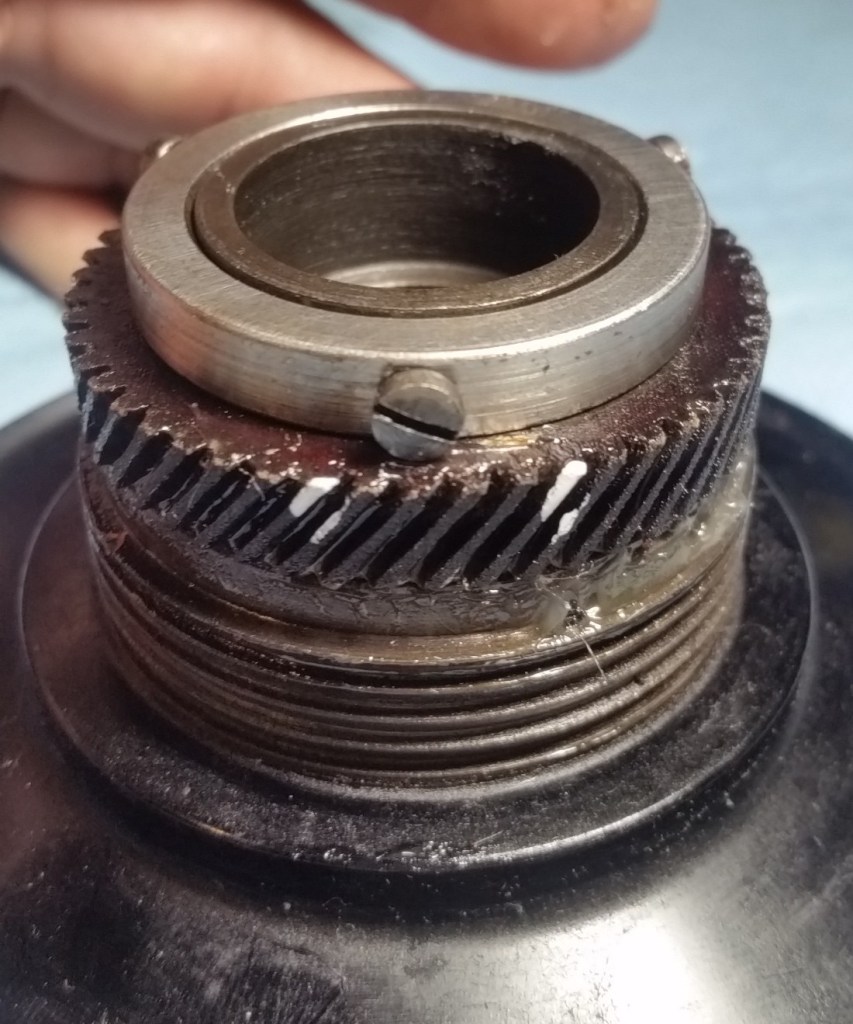
Note the position of the screw in the gear retaining collar at the top of the balance wheel. Think of this a the center position. I have put 2 white dots on the textolite gear to show the distance the gear is allowed to slip, thus absorbing any shock load the gear may encounter. I am going to keep the balance wheel in the same place and twist the gear.

The gear has a spring mechanism in it that allows gear movement to the position of the white dot. This absorbs the shock to the gear as the machine revs up.
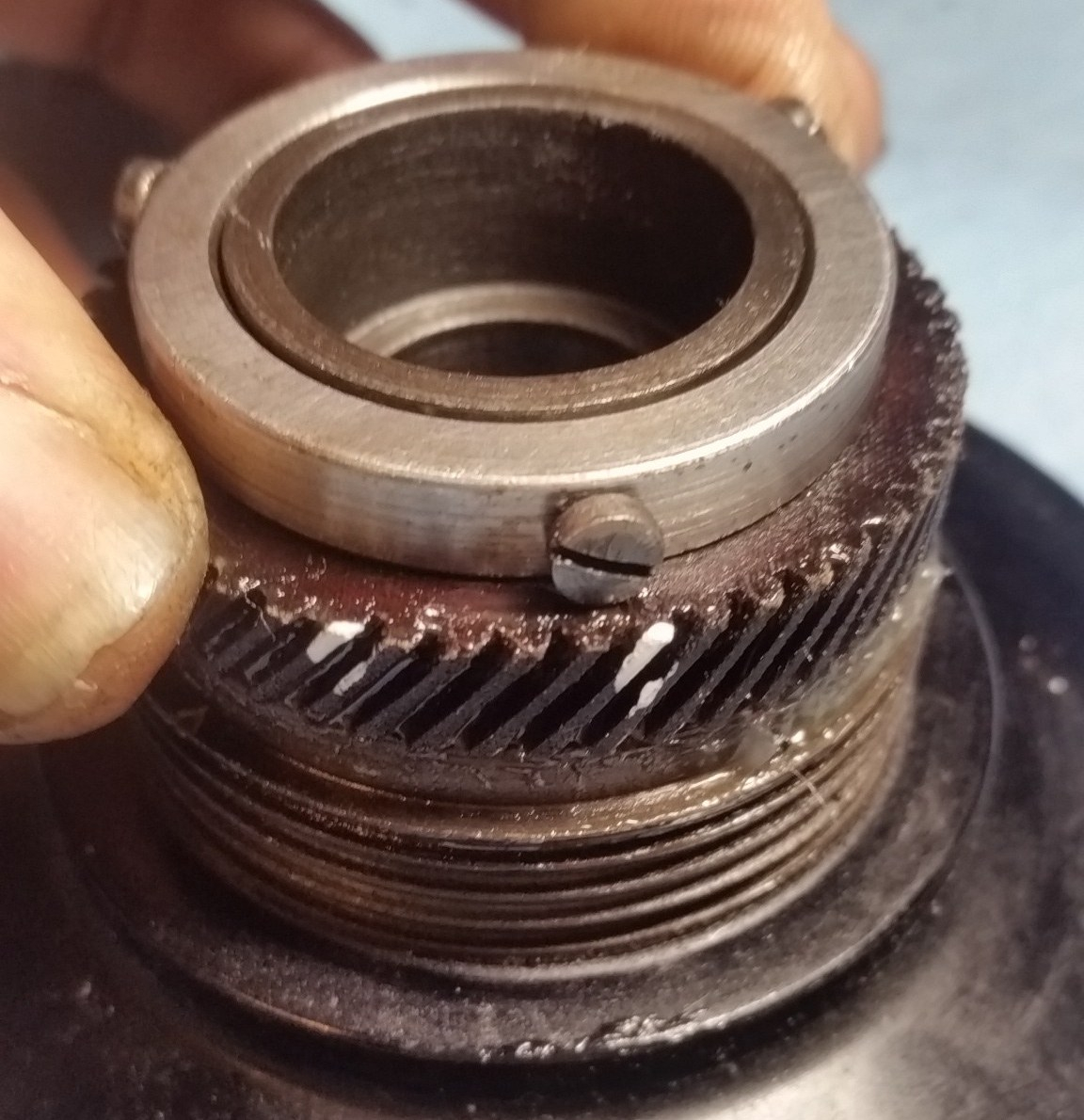
Notice the dot has moved in the opposite direction. This shows what happens when you stop the machine, for instance it hits an obstruction (maybe caused by changes in fabric thickness). This absorbs the shock to the gear as the machine slows down.
This is really quite a bit of distance allowed for the gear to rotate in relation to the balance wheel. Singer must of thought about this too, because a lot of design went into it. The next few pictures show how it works.
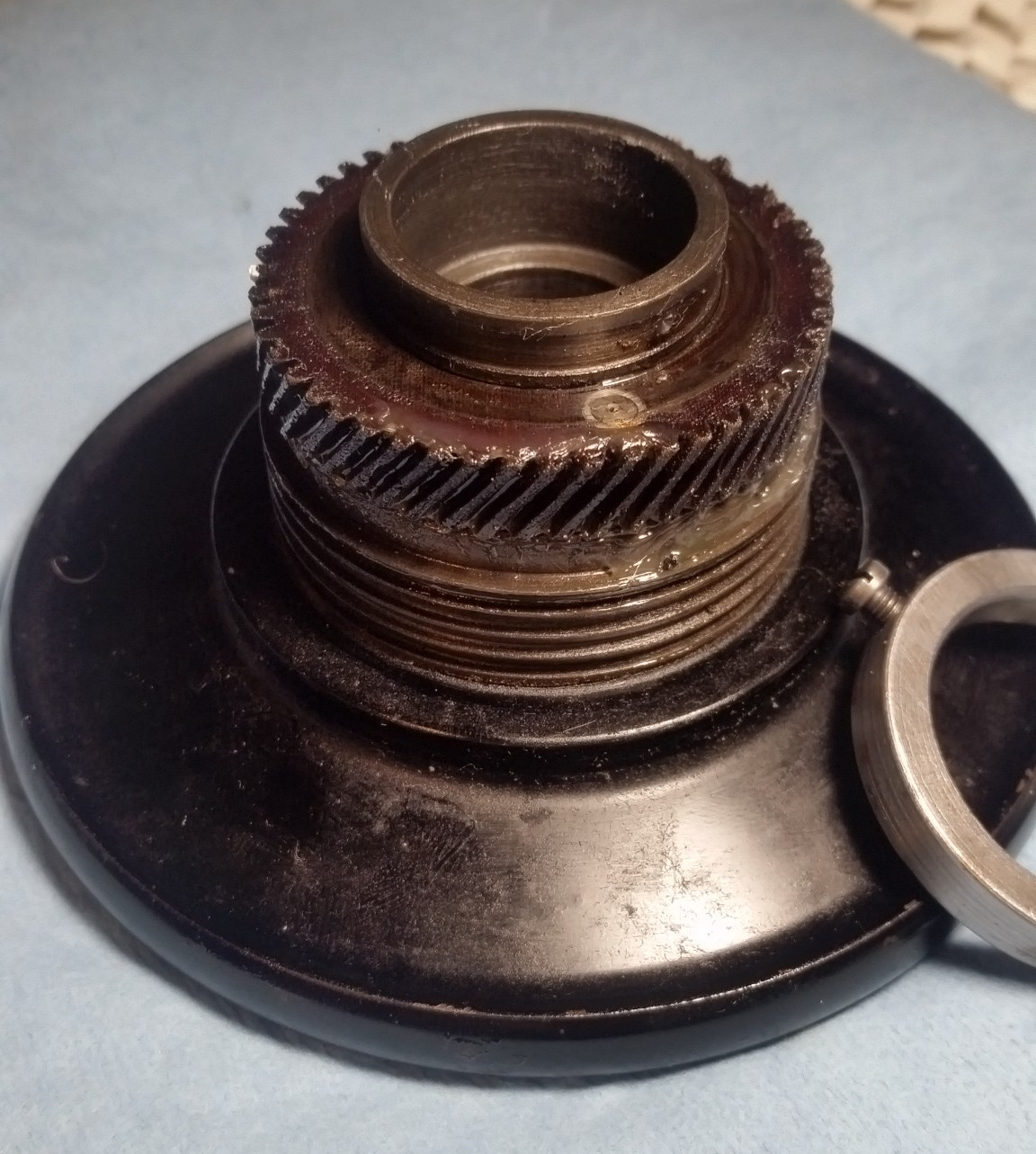
This is the textolite gear with the collar removed. See the small dot on the gear? That is a pin that goes thru the gear and engages in the end of a spring.
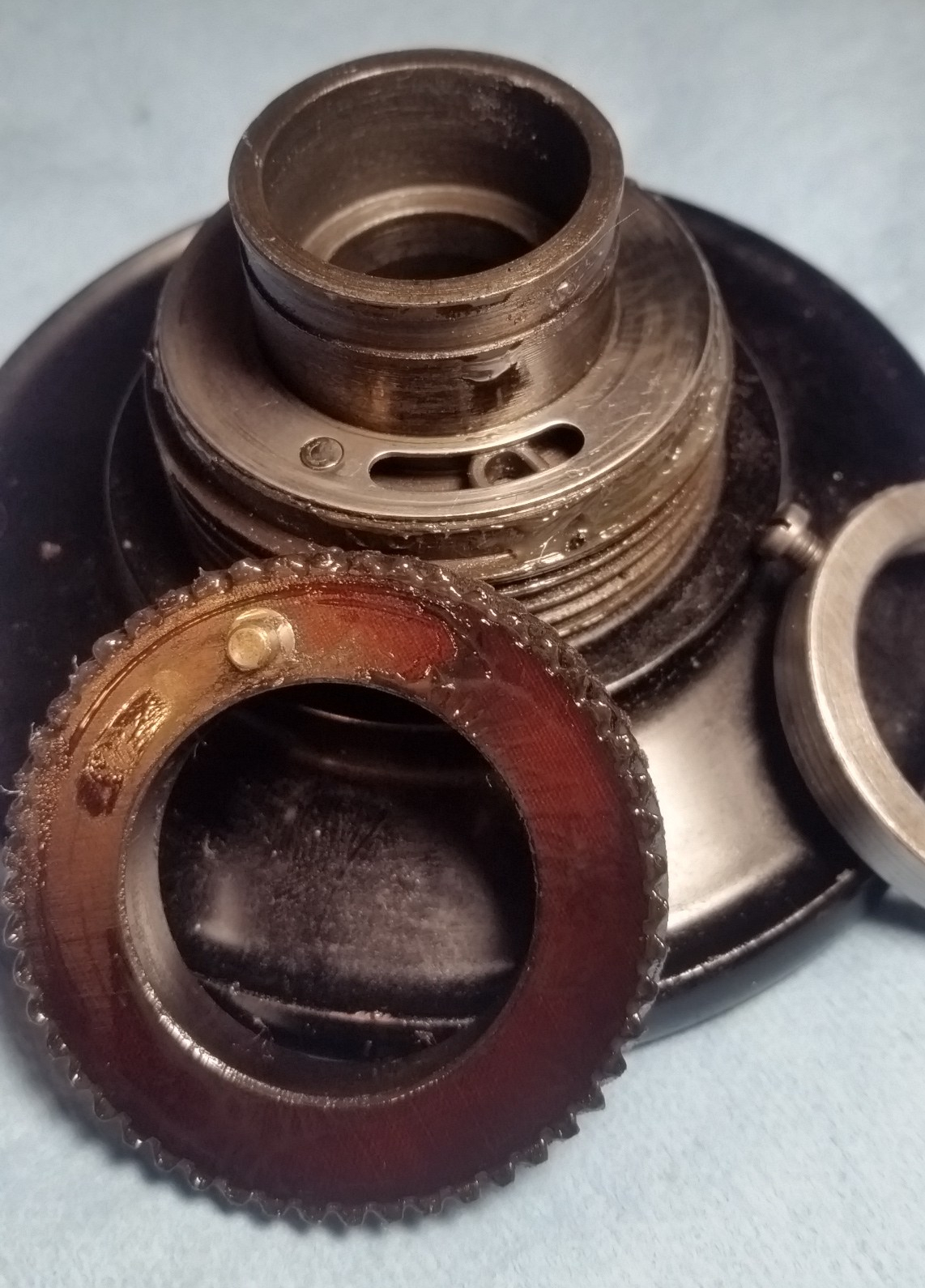
With the gear removed, you can see the pin in the gear and a cover plate over the spring. You can spot the end of the spring in the slot opening in the plate.
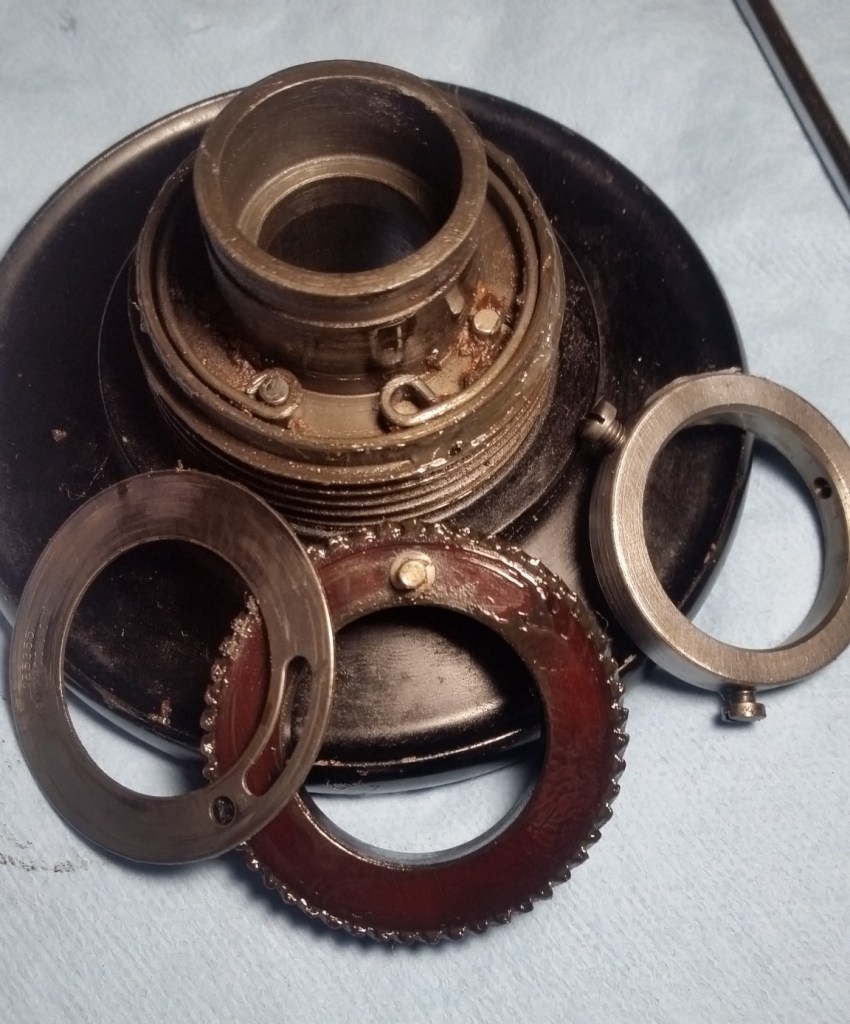
With the plate removed you see the spring… there are also 2 eccentric studs (1 you can see) that allow the spring to move evenly in the housing and support the spring thru its travel and evenly distribute the shock load on the spring. The other end of the spring fits on a pin set in the balance wheel. This spring mechanism allows the spring to rotate in both directions and absorb any shock caused at the motor, or at the needle.
Now, let me play the Devil’s advocate and say… “Well, MY gear broke and I told you so!” Well, even in the event the gear did break (I’m sure it has happened to someone somewhere) it is not disastrous. You can replace the gear, though it is a little bit of work, but the worst case scenario would be to replace the balance wheel… gear and all. I just checked and there are quite a few on Ebay for about $25 shipped. The repair is as simple as removing the balance wheel free motion knob and washer, the balance wheel pulls out easily, slip the new balance wheel on, replace the washer and knob, and you are done. Who knows, maybe you would prefer a prettier balance wheel and now is the opportunity to upgrade!
So that’s my textolite gear defense. This gear is made from a very durable material. The shock absorbing spring mechanism makes sure the gear is not over stressed. Don’t let the presence of this gear in the beautiful all metal vintage sewing machine you are considering deter you from buying it… Really.
So why is there a fiber gear in the machine you are claiming is all metal? Well, I’ll tell you. There are 4 places in an all metal sewing machine where material other than steel, bronze, brass, aluminum, or iron is generally accepted and the machine is still considered to be all metal. One is the textolite gear, the other is plastic pattern cams, another is a motor belt, and the last is plastic trim pieces and/or covers (I don’t particularly like plastic covers, but I don’t let them deter me form acquiring the machine).
Okay, so why did Singer put a textolite gear in the machine in the first place? Well, I don’t know. I don’t think it was a cost cutting measure… they didn’t cut costs anywhere else (in the early vintage models at least). My guess would be that the gear itself is intended to absorb shock. A textolite gear will absorb shock, while a steel gear would translate the shock to another component. It may also have been used to quiet the gear train. If you know, I would be glad to know the answer.
So, there you have it. Let me know if you agree or if you disagree. I would like to see more information on the topic.
Thanks for reading!

The gear failed on my machine–I need to take it in for repair. However, in the defense of Singer, it was in a very hot moving crate for months because due to the fault of the movers. The thing literally crumbled.
LikeLike
Hello Nicki,
I’m sorry to hear that! Can you tell me what model machine you have? It is really a simple repair.
Thanks!
Lee
LikeLike
Thanks for your description and your theories. I was fascinated to find this on a 201 and wondered about it.
LikeLike
One of the reasons for the textolite gear is to electrically insulate the machine body from the shaft of the motor, Singer direct drive machines, at least those that I own (401G, 411G, 431G, 675G, 670G) have a three wire plug, so the mains cable has two wires and no earth connection, and with such a design the main body of the machine must not touch any metallic part of the motor. In designs with no earthing and a belt usually the case and pulley of the motor is plastic, or the pulley sits on a plastic insulator that sits on the shaft, and if you look into Singer 328K you’ll find a plastic pulley and plastic insulators that hold the motor in place.
LikeLike
Hello Lukasz,
That is an interesting theory. I think that the reason for using textolite has more to do with reducing noise than it does with insulation. On a potted motor the motor is metal and it bolts to the machine with screws. The armature shaft runs on bronze bearings. One of the wires in the three wired plug is for the foot controller and passes the power from the main lead thru the controller independent from the light. If you look at the back of the plug terminal, you will see that one leg of the motor goes to a single connection. This is tied to the controller.
On all vintage sewing machine motors that I have worked on are “Universal” in that they can be used with DC current as well as AC current. These motors only have two power wires and no ground. They use 2 prong plugs and there is no ground to the receptacle.
There are many vintage machines that have external motors with steel belt pullys. The motor brackets are metal and attached to the body of the machine. I have not seen any insulator on the shaft under the pully.
Later Singer machines like the 328K have internal motors. These motors may have plastic pulleys, but I think it was more for reducing manufacturing costs than anything else.
I will confess that I am not used to every model Singer produced, and a machine not made in the US may be different.
Thanks for your input, and if there is anyone out there that can shed light on the topic, I hope they will post a comment.
Have a wonderful day!
Lee
LikeLike
My 403a has a white great in it where others have Textolite. It’s a 1951. . It appears like plastic or nylon. There has been discussion among the experts in the fb groups about if this is a cheap repair someone did or original, did they ever put this in a 403a? The machine seems to be working well… I’m new to vintage machines but after a good cleanings and oiling it sews well. I had a slight shake at full speed but could be it’s not on a solid table. Should I greese this gear? The manual shows greese lube put on this area. But I don’t know if that’s the original and naff this replaced one should not be greesesd. The Sew Retro greese says not to apply to nylon or plastic. Thank you for any feedback.
LikeLike
Hello Roe,
I have not seen a plastic, nylon, or white gear in a 403a. Perhaps it was replaced at some point?
You can ad a bit of grease, and Singer Lubricant, available in small tubes works well.
I hope this helps!
Lee
LikeLike